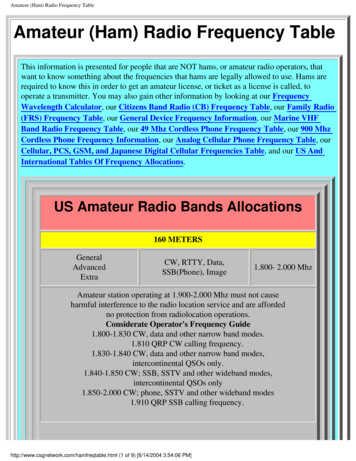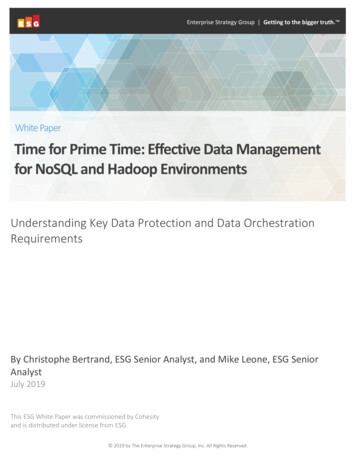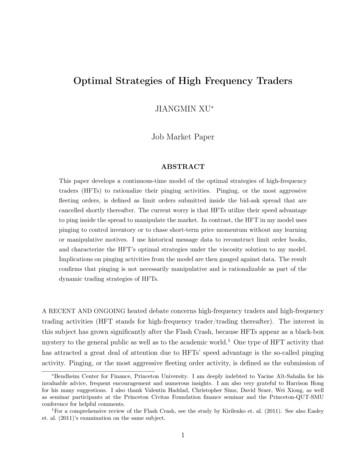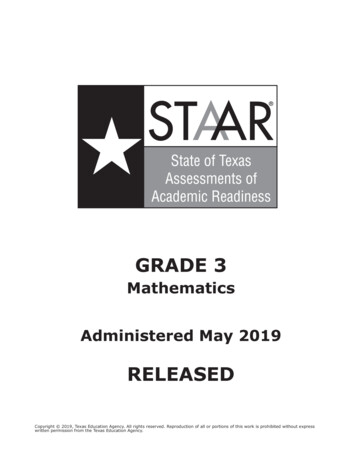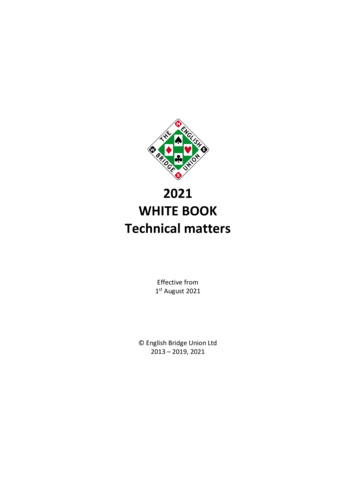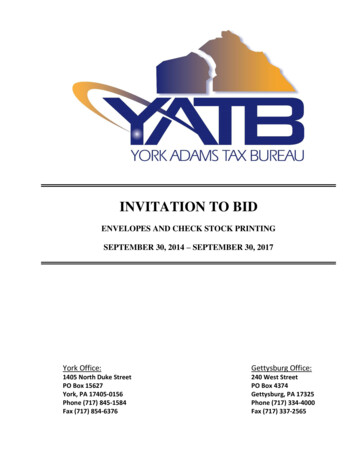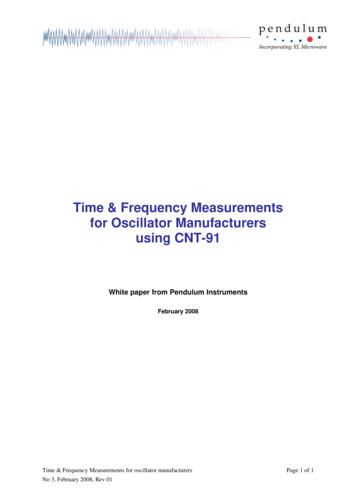
Transcription
Time & Frequency Measurementsfor Oscillator Manufacturersusing CNT-91White paper from Pendulum InstrumentsFebruary 2008Time & Frequency Measurements for oscillator manufacturersNo 3, February 2008, Rev 01Page 1 of 1
1. BackgroundInstruments for measurement of time or frequency are used for many different purposes at oscillatormanufacturers, at different departments:-Adjustment and verification of frequency (production)-Frequency verification to specs (QC – Quality Control)-Long term stability (ageing) of oscillators (production / QC)-Temperature stability measurements of oscillators (R&D / QC)-Short-term-stability test; ADEV vs τ (R&D or production)-Start-up performance (R&D / QC)-Wander parameter measurements (TIE, TDEV) in clock modules for telecom (R&D / QC)-Verification of frequency purity (finding frequency micro-glitches) in R&D-PLL parameter testing (R&D)-Phase comparisons of frequency standard clocks (Cal lab)-Calibration of other instruments (Cal lab)Several different instruments have traditionally been used for different types of measurements like:-Frequency only countersTimer-countersPhase comparatorsADEV-test setsModulation domain analyzersSDH synchronization testersetc.With the CNT-91 from Pendulum Instruments, you can perform all these measurements, with orwithout the optional Modulation Domain SW TimeView in one single instrument, combining theessential properties of the instruments listed above.The following pages will show some examples where the CNT-91 will give highest possibleperformance for typical measurements in oscillator R&D and manufacturing processes.Time & Frequency Measurements for oscillator manufacturersNo 3, February 2008, Rev 01Page 2 of 2
2. CNT-91-50 ps single-shot time resolution for very accurate phase comparisons of reference clocks-12 digits/s resolution for ultra-fast frequency measurements-zero-dead-time measurements for fast measurements and frequency/phase glitch capturing-built-in TIE measurements to measure TIE and TDEV for network clocks-up to 4k individual results/s over GPIB for fast data transfer-up to 10k streaming block measurements/s continuously-modulation domain analysis (with optional TimeViewTM SW) to replace HP53310A inexisting lab set-ups-HP53132A emulation mode, for plug and play replacement in older test systemsCNT-91 is the ideal tool for all companies manufacturing oscillators and clock modules.In production test stations, the high resolution and measurement speed, together with HP53132AGPIB emulation mode, makes CNT-91 the best choice for frequency adjustment and verification.In the Quality Control Dept, the CNT-91 – with or without TimeView – can be used for all types ofverification of frequency or time parameters, e.g. ageing over days, weeks or months, frequencyvariation due to environmental changes of e.g. temperature, verification of Wander parameters (TIE,TDEV) on sample tests, verification of short-term stability (ADEV), etcIn the calibration lab, the high 50 ps time interval resolution enables accurate and fast phasecomparisons between in-house frequency standards. The measurement versatility makes CNT-91 theideal calibrator for frequency time-bases in e.g. generators, spectrum analyzers etc. or for time-intervalor phase calibrations.In R&D, the modulation domain SW (TimeViewTM ) enables fast and high resolution measurements offrequency vs time, to e.g. characterize start-up behaviour of oscillators, automatic measurements ofshort term stability (ADEV vs τ), analysis of clock PLL design in the design phase, sample testing ofwander parameters (TIE, TDEV), detection of frequency glitches, etc.Time & Frequency Measurements for oscillator manufacturersNo 3, February 2008, Rev 01Page 3 of 3
3. TimeViewTM Modulation Domain Analysis SWFigure 1. A TimeView plot of ADEV vs τ for an OCXOWhat TimeView does:For R&D engineers, the optional TimeViewTM Modulation Domain Analysis SW provides valuableinsight in an oscillator’s short-term and start-up behaviour, which no other type of instrument can do.Furthermore TimeView can monitor ageing, measure TIE (for network clocks) and find any frequencyanomaly (glitches, phase shifts) in oscillatorsHow TimeView works:TimeView takes the zero-dead-time frequency, time or phase data from CNT-91, and displays andprocesses the data.The basic presentation mode is to show the variation of frequency, time or phase vs time. This uniquemodulation domain presentation mode, is unique for a modulation domain analyzer (like thecombination of CNT-91 and TimeView) and reveals signal properties that complement the traditionaltime domain (oscilloscope view) or frequency domain (spectrum analyzer view).The statistics presentation mode presents numerical statistics and histogram presentation to revealjitter types and possible modulationThe FFT presentation detects both intentional and unwanted modulation of the oscillator frequencyThe timestamp presentation mode is used to e.g. calculate short-term stability ADEV over τ. See plotin figure 1 aboveTime & Frequency Measurements for oscillator manufacturersNo 3, February 2008, Rev 01Page 4 of 4
4. Ultra-fast frequency adjustment and testing in productionHigh-volume production testing of oscillators is made in automated test system using custom designedtest jigs for several oscillators, that are either measured in parallel or sequentially switched. Totalthroughput is limited by the handler, the measurement time, the oscillator-switching overhead, and thedata transfer time. In these measurements, bus measurement speed and resolution are keyparameters. CNT-91 offers ultimate resolution (1E-11 at just 100 ms measuring time), and GPIB busspeed (up to 4k low-resolution measurements/s).To verify frequency to 8 significant digits requires only 5 ms of measurementFast switching between FREQ A and FREQ BA fast way of doing frequency measurements on oscillator-DUTs (DUT Device Under Test), is to letthe handler connect two oscillators at a time to one counter, to input A respectively input B. Thatmeans the test sequence is:Connect DUT 1 and 2 to input A and B, measure A, measure B,switch to DUT 3 and 4 to input A and B, measure A, measure B, etcInstead of:Connect DUT 1 to input A, measure A,switch to DUT 2 to input A, measure A,switch to DUT 3, etcIn CNT-91, the switching time to make first a measurement on A then on B is 30 ms, which should becompared to the time it takes the handler to switch DUTsShort start time-out to detect faulty DUTsOne of the problems with fast production test of oscillators is that a DUT can be faulty. That meansyou let the handler connect the DUT to the counter, you start the measurement and - nothing happens.The oscillator under test is broken and gives no output signal. Some counters may more or less waitforever until the controller aborts the started frequency measurement. Other counters haveprogrammable time-out and can abort the measurement automatically.One problem with time-out settings in traditional counters is that they define the time when themeasurement should have stopped, not started, and the time-out time must be longer than the gate time(measuring time). For example, if the measuring time is 500 ms, the time-out should be set to e.g. 600ms, meaning you need to wait 600 ms before you know that the DUT is broken.CNT-91 can set time-out both for start and stop of the measurement, and can be set to a very shortstart time-out-time out of just 10 ms, to quickly detect faulty oscillatorsLow volume production testingFor low volume production testing, you may see semi-automatic test stations, with manual handling ofthe DUTs, and sometimes even manual read-out. In these applications, the CNT-91 offers someunique advantages, like:-graphical representation of test limits on the built-in display-USB connector to the PC running test SW (no need to invest in GPIB-cards)Time & Frequency Measurements for oscillator manufacturersNo 3, February 2008, Rev 01Page 5 of 5
5. Oscillator start-up measurementsA common task in oscillator manufacturing is to verify the oscillators start-up performance. In otherwords, how long time after switch-on is the oscillator operating with ”satisfactory” frequencyaccuracy. The accuracy limits are typically in the order of one or a few ppm.The Pendulum Instrument CNT-91 timer/counter/analyzer provides a very cost-effective solution tothis measurement problem, via the unique feature of continuous timestamping.The CNT-91 has a very-high resolution also for short measurement times, and the unique Frequencyback-to-back (FREQ BtB) measurement function. With this function, you avoid the dead time betweenmeasurements, which is found in the “normal” Frequency measurement function.Set-up1. Connect the oscillator under test (DUT) to the CNT-91 and supply voltage as shown in figure 22. Connect the CNT-91 via USB or GPIB to a PC running an application program, e.g. TimeViewTM.3. Set a suitable measurement time that fits the required resolution. E.g. 50 microseconds for 1 ppmresolution/sample in CNT-914. Set an array size with a suitable number of samples (define the total time to capture frequency data).E.g. 200 Samples and 50 microseconds Frequency back-to-back measurements gives a total time forthe measurement of 50µs * 200 10 ms5. Switch on supply voltage to DUT, start to measure, and get the dataPowersupplyCNT-9110 pFInput AV DUTOsc.out220 ΩGndFigure 2. Set-up for Oscillator start-up measurementsThe supply voltage change (a positive slope through the capacitor) is transferred to the countersmeasurement input as a trigger slope, and generates first timestamp (time 0 ns), the followingtimestamps are generated by the oscillations of the DUT.The timestamps are taken at intervals defined by the set measuring time. See figure 3measuring timeInput Atrigger leveltimestampsFigure 3. The set measuring time defines the time between samplesTime & Frequency Measurements for oscillator manufacturersNo 3, February 2008, Rev 01Page 6 of 6
Using TimeView to measure oscillator warm-upTimeView is set up for Frequency BtB measurements and free-run data capture. An example with a 10MHz TCXO as DUT, using 200 µs measuring time is shown below (fig. 4):Figure 4. TCXO output frequency vs time after power up (leftmost red cursor)The TimeView graph shows the frequency samples (Y) over a time axis (X). The first sample is thetime-stamped power-on trigger (red cursor) and also the origin of the TimeView time scale.The following samples are a sequence of 200 µs measurements starting after approx 1.3 ms (greencursor X-read-out), when the oscillator starts to generate its first oscillations. A zoom-in in the abovegraph reveals more details (fig. 5):Figure 5. Zoom-in on start-up frequency plotTime & Frequency Measurements for oscillator manufacturersNo 3, February 2008, Rev 01Page 7 of 7
6. Wander parameter measurements (TIE, TDEV) in clock modules fortelecomOscillators and clock modules intended for use in synchronous telecom networks, sometimes has anadditional specification for wander parameters (sometimes MTIE, but most often TDEV). Thesewander parameters are post-processed results of the basic TIE-measurement (TIE Time IntervalError). TIE is the time difference between the trigger event (normally the zero-crossing) of the actualclock or data signal, compared to the ideal clock signal. TIE 0 for the first value taken at time t 0,and TIE is thereafter the accumulated phase difference relative the first sample taken.CNT-91 is the only counter on the market with built-in TIE-measurements, thanks to the continuouszero-dead-time measurement principle. TIE is calculated in CNT-91 asE E0TIE (i ) Ti T0 iFreqnomContinuous Time-stamping Zero dead-timetriggerlevelTimestamp(Ei, Ti)Timestamp(E i 1, Ti 1 )Timestamp(Ei 2, Ti 2 )Timestamp(Ei 3, Ti 3 )Timestamp(Ei 4, Ti 4 )Figure 6. Zero-dead-time timestamping is an absolute must for TIE-measurementsFor e.g. a Stratum 1 type of 1.544 MHz clock, each zero crossing should ideally occur with a timedifference of exactly 647.668 393 782 383 ns between trigger events. The ideal time stamp, for e.g. 10million trigger events from start of measurement, should be 6.476 683 937 8 s.Now assume that the timestamp of the actual signal for the 10 millionth time stamp is 6.476 683 1000. That means that the TIE for time t 6.48s equals 837.8 ns (the difference between actual and idealclock.The TimeViewTM SW is an ideal tool to display TIE in a lab environment. See figure 7 below. TheTIE file can be exported into a spreadsheet program, e.g. Excel, for further processing.Figure 7. A TIE vs time graph in TimeViewTime & Frequency Measurements for oscillator manufacturersNo 3, February 2008, Rev 01Page 8 of 8
7. Short-term stability testing (ADEV vs τ)Short-term stability of oscillators is measured as Allan Deviation (ADEV) for various measurementtimes. Correct ADEV calculation assumes zero-dead-time or back-to-back measurements, whichmeans that traditional counters cannot be used. Only zero-dead-time timestamping counters.ADEV is the RMS of the difference between any two back-to-back frequency samples fk and fk τ,each of length τ, over any 2τ period.Continuous Time-stamping Zero dead-timetriggerlevelTimestamp(Ei, Ti)Timestamp(Ei 1, Ti 1 )Timestamp(Ei 2, Ti 2 )Timestamp(E i 3, Ti 3 )Timestamp(Ei 4, Ti 4 )Figure 9. Frequency back-to-back is easily calculated from timestamp dataFrequency back-to-back samples fi over τ seconds each, are calculated as:fi E i E i 1Ti Ti 1With TimeView and CNT-91 you can make automatic calculation of short-term stability ( σy or ADEVvs τ) of any frequency source up to 20 GHz, using the built-in formula:1 k n 1σ τ) ( y (t k τ ) y (t k )) 22(n 1) k 02y( y(k) is the fractional frequency deviation [ y(k) ( fk – fref ) / fref ]Figure 10. A TimeView plot of ADEV up to 5000s, showing a typical OCXO behaviourTime & Frequency Measurements for oscillator manufacturersNo 3, February 2008, Rev 01Page 9 of 9
8. ConclusionThe CNT-91 zero-dead-time timer/counter/analyzer, with or without the TimeView ModulationDomain SW, can be used for several measurements common in oscillator manufacturing:-Adjustment and verification of frequency (production)-Frequency verification to specs (QC – Quality Control)-Long term stability (ageing) of oscillators (production / QC)-Temperature stability measurements of oscillators (R&D / QC)-Short-term-stability test; ADEV vs τ (R&D or production)-Start-up performance (R&D / QC)-Wander parameter measurements (TIE, TDEV) in clock modules for telecom (R&D / QC)-Verification of frequency purity (finding frequency micro-glitches) in R&D-PLL parameter testing (R&D)-Phase comparisons of frequency standard clocks (Cal lab)-Calibration of other instruments (Cal lab)CNT-91 Timer/Counter/Analyzer features-The highest resolution and speed available in any timer/counter on the market-The only Modulation Domain Analyzer currently on the market-The only zero-dead-time frequency back-to-back counter on the market-The lowest-cost ADEV vs t tester on the market-And - last but not least – the CNT-91 provides a very cost-effective solutionTime & Frequency Measurements for oscillator manufacturersNo 3, February 2008, Rev 01Page 10 of 10
White paper from Pendulum Instruments February 2008 . Time & Frequency Measurements for oscillator manufacturers Page 2 of 2 No 3, February 2008, Rev 01 1. Background . - SDH synchronization testers - etc. With the CNT-91 from Pendulum Instruments, you can perform all these measurements, with or

